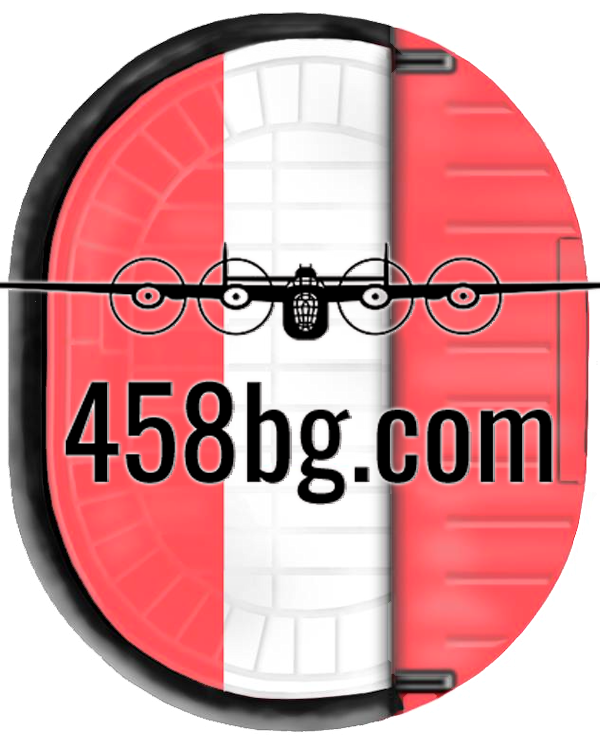Holmgren Crew – Assigned 752nd Squadron – February 13, 1945
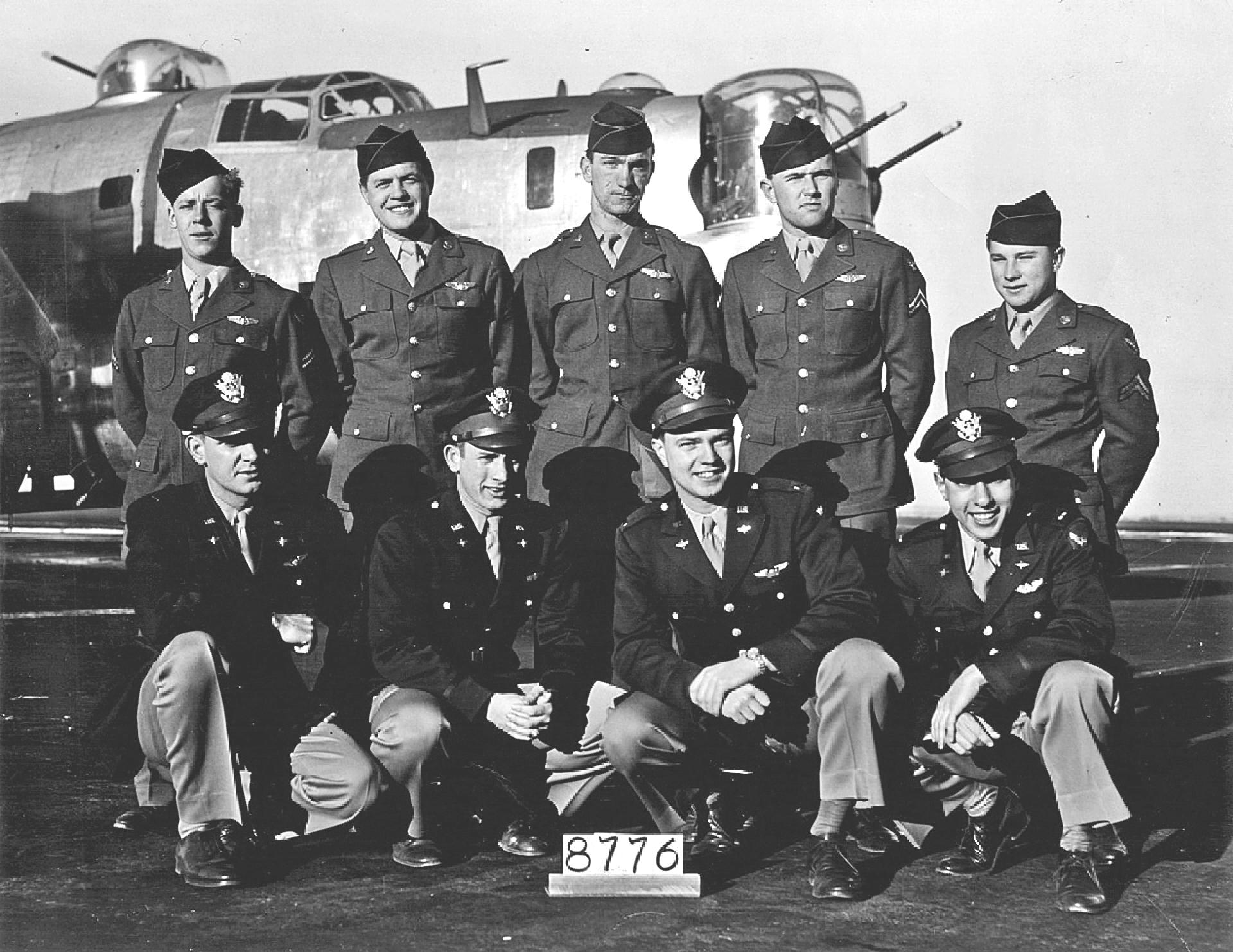
Not pictured: Harry Schafer – G
(Photo: Jeff Bull)
Flying at the End of Hostilities
| Rank | Name | Serial # | Crew Position | Date | Status | Comments |
|---|---|---|---|---|---|---|
| 2Lt | Edward L Holmgren | 02057216 | Pilot | 07-Jun-45 | FEH | Ferry Liberator to States |
| F/O | Herman W Bull | T64227 | Co-pilot | 07-Jun-45 | FEH | Ferry Liberator to States |
| 2Lt | Paul H Gable | 02073104 | Navigator | 07-Jun-45 | FEH | Ferry Liberator to States |
| F/O | Jerome K Borak | Bombardier | Jan-45 | UNK | Not assigned with Crew | |
| S/Sgt | Rollin A Helbling | 36824907 | Radio Operator | 07-Jun-45 | FEH | Ferry Liberator to States |
| S/Sgt | Joseph R Metosh | 33631930 | Flight Engineer | 07-Jun-45 | FEH | Ferry Liberator to States |
| Sgt | Dean W Burke | 32938156 | Aerial Gunner | 07-Jun-45 | FEH | Ferry Liberator to States |
| Sgt | Harry F Schafer, Jr | 42093502 | Aerial Gunner | 07-Jun-45 | FEH | Ferry Liberator to States |
| Sgt | Ted Semchuck | 35606587 | Armorer-Gunner | 07-Jun-45 | FEH | Ferry Liberator to States |
| Sgt | Thomas L Richardson | 18242507 | Aerial Gunner | 07-Jun-45 | FEH | Ferry Liberator to States |
The Holmgren crew arrived at the 458th Bomb Group 71 days before the air war in Europe would cease. Nevertheless, the crew was able to fly 12 combat sorties before the last Eighth Air Force mission was flown on April 25, 1945. After flying as co-pilot with another crew on March 8th, Holmgren took his own crew on their first mission to Arnsburg, Germany on March 10th and their last was flown on April 20, 1945 to Zweisel, Germany. The group flew only one mission after this, five days later to Bad Reichenhall.
Nine of the crew’s twelve missions were flown in one of the oldest ships in the group. B-24H 41-29340 Yankee Buzz Bomb was an original group aircraft assigned to the 752nd Squadron, and, unlike most of the aircraft in the group, this one remained in this squadron throughout the group’s time in the ETO. The last time that Holmgren’s crew flew this aircraft on April 15th, they took it on its 81st mission and were photographed on the bomb run. [See picture below]
Originally the charge of the Ronald A. Gulick crew, Ship #340 was not without a colorful past. On October 7, 1944 flown by the Albert Grice crew, Yankee Buzz Bomb aborted the mission (her 52nd) to Magdeburg after losing two engines. The bombs were accidentally salvoed through the bomb bay doors creating a tremendous drag. Reaching the English coast, Grice ordered his crew to bail out. Seven members parachuted, but tragically the chute of gunner Sgt Edward Mire failed to open. Grice, his co-pilot, and flight engineer stayed with the plane and managed to land safely in a barley field about four miles southeast of Cromer. The aircraft was repaired by 3rd SAD and returned to Horsham St. Faith on November 17th. At some point after this date, the aircraft was stripped of her olive drab paint job and apparently her name as well.
This was not the only time that members of a combat crew bailed out of Yankee Buzz Bomb on a combat mission. The Holmgren crew was the second on the April 5, 1945 mission to the marshaling yards at Plauen, Germany. [See Stories page Ice and Fire].
At this late stage of the war bombardiers who trained with crews in the States were most often reassigned prior to coming overseas. Such was the case with Flight Officer Jerome K. Borak. It is not known what became of him or if he made it overseas prior to the war ending.
Not having completed a combat tour, Holmgren was tasked to ferry one of the group’s Liberators back to the States. They drew a fairly new ship that they had flown on April 16th when, for unknown reasons, the crew was forced to abort after the group had assembled. This aircraft, B-24J-160-CO 44-40424 7V F Monya, was a fairly new arrival in the 752nd Squadron and had been on only six trips over Germany.
Missions
| Date | Target | 458th Msn | Pilot Msn | Serial | RCL | Sqdn | A/C Msn | A/C Name | Comments |
|---|---|---|---|---|---|---|---|---|---|
| 08-Mar-45 | DILLENBURG | 199 | 1 | 44-10487 | R | 7V | 39 | Girl on surfboard (no name) | HOLMGREN CO-PILOT |
| 10-Mar-45 | ARNSBURG | 201 | 2 | 41-29340 | N | 7V | 66 | YANKEE BUZZ BOMB | |
| 17-Mar-45 | HANNOVER | 205 | 3 | 41-29340 | N | 7V | 69 | YANKEE BUZZ BOMB | |
| 19-Mar-45 | LEIPHEIM | 207 | 4 | 41-29340 | N | 7V | 70 | YANKEE BUZZ BOMB | |
| 21-Mar-45 | HESEPE | 209 | 5 | 44-40126 | L | Z5 | 70 | SPITTEN KITTEN / SKY TRAMP | |
| 04-Apr-45 | PERLEBERG | 217 | 6 | 41-29340 | N | 7V | 75 | YANKEE BUZZ BOMB | |
| 05-Apr-45 | PLAUEN | 218 | ABT | 41-29340 | N | 7V | -- | YANKEE BUZZ BOMB | ABORT - HEAVY ICING |
| 07-Apr-45 | KRUMMEL | 220 | 7 | 42-95316 | H | 7V | 101 | PRINCESS PAT | |
| 09-Apr-45 | LECHFELD | 222 | NTO | 41-29567 | G | 7V | -- | MY BUNNIE / BAMBI | CROSSED OFF FP |
| 10-Apr-45 | RECHLIN/LARZ | 223 | 8 | 41-29340 | N | 7V | 79 | YANKEE BUZZ BOMB | |
| 11-Apr-45 | REGENSBURG | 224 | 9 | 41-29340 | N | 7V | 80 | YANKEE BUZZ BOMB | |
| 14-Apr-45 | POINTE DE GRAVE | 225 | NTO | 41-29340 | N | 7V | -- | YANKEE BUZZ BOMB | NO TAKE OFF - Flat tire |
| 15-Apr-45 | ROYAN AREA | 226 | 10 | 41-29340 | N | 7V | 81 | YANKEE BUZZ BOMB | PHOTO |
| 16-Apr-45 | LANDSHUT | 227 | ABT | 44-40424 | F | 7V | -- | MONYA | ABORT - REASON? |
| 18-Apr-45 | PASSAU | 228 | 11 | 41-29352 | K | 7V | 94 | WOLVE'S LAIR | |
| 19-Apr-45 | ZWIESEL | SCR | -- | 44-10487 | R | 7V | -- | Girl on surfboard (no name) | SCRUBBED |
| 20-Apr-45 | ZWIESEL | 229 | 12 | 42-51110 | M | 7V | 107 | TOP O' THE MARK |
1Lt Edward Holmgren Mission Diary

Mission No. 1
8 March 1945
Dillenburg
T.O. 1030 Landing 1700
Ship 352K-7V
I flew my first mission today as co-pilot to Lt. J. O’Regan. Frankly it wasn’t as rough as I anticipated. It was a comparatively short haul. We carried 24 X 250lbs G. P. bombs. We flew in the third squadron of the group. From all reports we missed the target rather badly (20 to 25 miles). This is due in the main to the lead squadron’s inability to drop due to the position of another squadron below our group. As a result the first squadron of our group did not bomb, and scattered ships in the remaining two squadrons dropped rather long of the MPI. The target was marshaling and railroad repair facilities east of the Ruhr, which if hit successfully would have seriously endangered the Wehrmacht’s ability to transport troops and supplies to the Western Front. For my first mission it was quite an experience, however, I was not really frightened at any given time, perhaps this is due to the complete absence of any flak anywhere along the entire route. I am tired now and feel as though I have had a full day. The thought now comes to my mind if these two years which I have spent in training have been worthwhile in terms of final victory, and my contribution thereto. One down, thirty-four to go. And so to bed.
Mission No. 2
10 March 1945
Arnsberg
T.O. 0800. Landing 1515
Ship 340N-7V
This was a considerably less difficult mission than its predecessor. This may be due to the fact that my entire crew flew with me for the first time on a combat mission, and the boys all did a swell job. Our target was a railway viaduct bridge leading into a marshaling yard at Arnsberg. This may be considered as being both tactical and strategic in nature as it was conducted in an effort to prevent supplies from reaching the Western Front, less than a hundred miles away. Since we bombed through a 10/10 under cast, results of the bombing were unobserved. Our position in the formation was No. 2 of the 2nd element of the 2nd squadron. The 458th was last in the wing. I might add that Herman and I flew a pretty fair bit of formation throughout. The route out and back was practically identical. It took us over the English Channel into northwestern France, south of Cologne (where a battle now rages) and thence north into target. Two down, thirty-three to go. And so to bed.
Mission No. 3
17 March 1945
Hanover
T.O. 1030 Landing 1700
Ship 350N-7V
The take-off belonged to the category of those which one “sweats out”. Had very little air speed for take-off so I wound up “56 Hg” before we finally cleared ground. We really gave that pub at the end of the runway a good buzz job. Our load was 12 X 500 lb G. P. bombs and 2000 gallons of fuel. Had no trouble from there on out. We flew the high right element of the second squadron; the group led the wing. Our target was a tank factory on the west side of the city of Hanover. There were 10/10 clouds at the target, so results were unobserved. The route on the return was virtually the same as that going out. We had to bomb at 25,000 due to clouds at briefed altitude. The flak, briefed as intense (200 guns) was meager and inaccurate. Saw two barrages at our altitude over the target, however no one was hit. Upon return to the coast visibility was very bad so we came in at two 2,000 feet over the Channel. Luck was riding with us again – I sincerely hope it continues from here on out. Three down, thirty-two to go. And so to bed.
Mission No. 4
19 March 1945
Gunzberg
T.O. 1015 Landing 1845
Ship 340N-7V
This was a pretty good mission from start until almost its end. The one bad feature was the undue length – 8-1/2 hours. Our target was a jet aircraft component and assembly plant in Western Germany, near Augsburg. The route was an extremely long one. Because of weather conditions over England, we were obliged to assemble over the Continent near Liege, Belgium. We came back out across Holland and the Zuider Zee. It was my first mission in which visual conditions prevailed throughout. Saw many of the oft fought over and bombed cities of France and Germany. I flew lead ship of the second element of the first squadron. (Good job, too.) The target area was thoroughly covered by our bombs. We carried 5,000 pounds of M17 incendiaries. Upon return to the base, instrument weather conditions prevailed. The ceiling was 800 feet, and visibility approximately 1/2 mile. After the peel off we began our instrument let down flying almost 500 feet over the Channel back on to the coast. Just before hitting the Buncher, No. 4 cut out due to exhaustion of fuel. There was nothing to do at this dangerously low altitude but feather it. Directly after this we spotted the field and landed on 3 engines. To say the least, I was very relieved. I don’t think I ever sweated out a landing like that one. Four down, thirty-one to go. And so to bed.
Mission No. 5
21 March 1945
Hesepe
T.O. 0640 Land: 1200
Ship 186L-Z5
This mission is what is commonly referred to in aviation circles as a “milk run”. It lasted but 5:20 hours, and was really a relief after the previous 8-1/2 hour mission. Our target (right) was a jet airfield in northwest Germany, just over the Dutch border about 75 miles. I had a little trouble on the assembly. This was due to our taking off last, and the failure of the radio compass. Since it was contact all the way up to assembly altitude and the entire 2nd AD was departing at practically the same time, I had some difficulty spotting our group. After tagging onto two or three strange groups I finally found the 458th just as they were departing the coast for the D.A.L. From there on we had no real trouble. We flew right wing on the high right of the fourth squadron, and had some trouble keeping in position due to the lower speed flown throughout. All our bombs did not release. One cluster (we carried 52 X 100 fragmentation bombs), failed to go either electrically or manually. Consequently, shortly after we reached the Channel on the way out we left the formation for the jettison point and picked it out. We returned to base at the same time as the rest of the group. Five down, thirty to go. And so to bed.
P.S. I failed to mention that the target was visual and we plastered hell out of it. The fourth squadron did the best job of the group, getting 95% hits within 1,000 feet of the M.P.I.
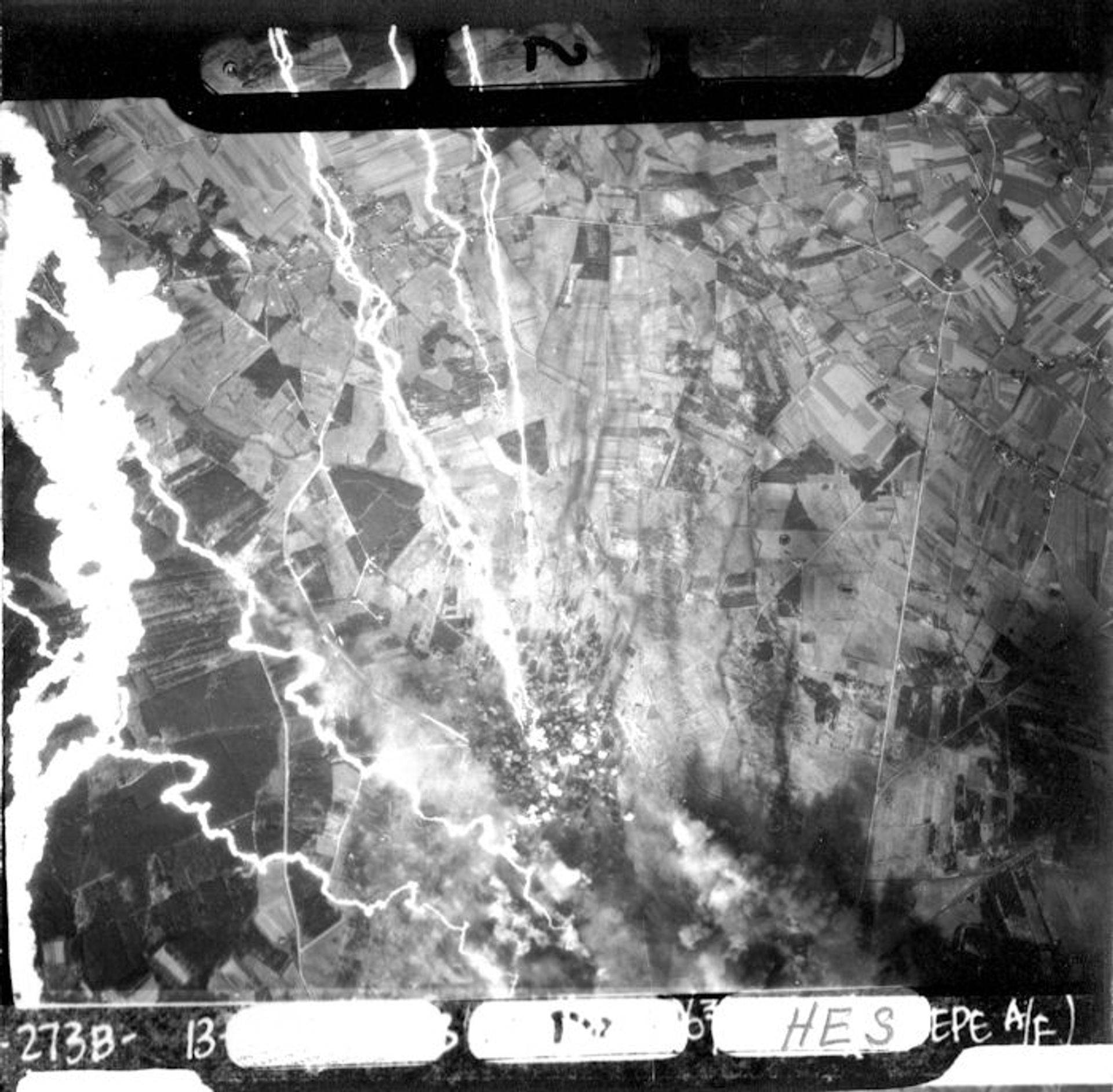
Mission No. 6
4 April 1945
Perleberg
T.O. 0615 Landing 1345
Ship 340N-7V
Today’s “piece de resistance” was a rather SNAFU deal, all the way around. After a takeoff made while it was still dark (something I hadn’t done since those horrendous days at Casper) the assembly proceeded without delay. We flew the slot of the second element of the second Squadron. The group was arranged for a maximum effort with four squadrons – two in the lead and the remaining two on the high left. Our target was an airfield in northern Germany about 60 miles northwest of Berlin. As a result of the Allied advances into western Germany, the Luftwaffe (what remains) has been forced to retreat to airfields in this locale. The bomb load consisted of 52 X 100 lb G. P.s. The route out took us over the North Sea, then into Germany south of Hamburg. We were instructed to bomb only if the target was visible. If this could not be accomplished, we were to resort to any other airfield in the vicinity. However neither of these two were accomplished and we returned to base with our bombs; save for the first squadron which was able to see the target through a break in the cloud cover. We were briefed for a little flak, however, there came a rude awakening when we turned on the IP and a barrage (small but extremely accurate) found my squadron. We suffered hits in the nose turret, wings, No. 2 engine, both wings, waist, tail turret, and tail surfaces. No one was injured, however Burke, the nose gunner was extremely lucky not to have been hit when a piece of flak burst through the plexiglass and shattered the bullet proof glass. His face was spattered with fragments of glass. Later, on our withdrawal through western Germany, we were attacked by enemy fighters (Me-262). None of them got close enough to make a successful attack, but were kept away by the vigilance of our gunners, and the ever presence of our escort (P-51s). Nothing eventful until our return to base when it became apparent that we may not have sufficient fuel for the trip home. However, I decided to make the gamble. We arrived at the English coast in good shape – still sweating out the gas. We decided to land before the group made its peel off. Shortly after we left the formation, No. 3 begins wind-milling from lack of fuel. This was taken care of by putting the selector valves on cross-feed, and it returned to life. Then we landed after a very unorthodox pattern and approach. All in all, a rather poor day in terms of profit and loss. And that’s six down, twenty-nine to go. And so to bed.
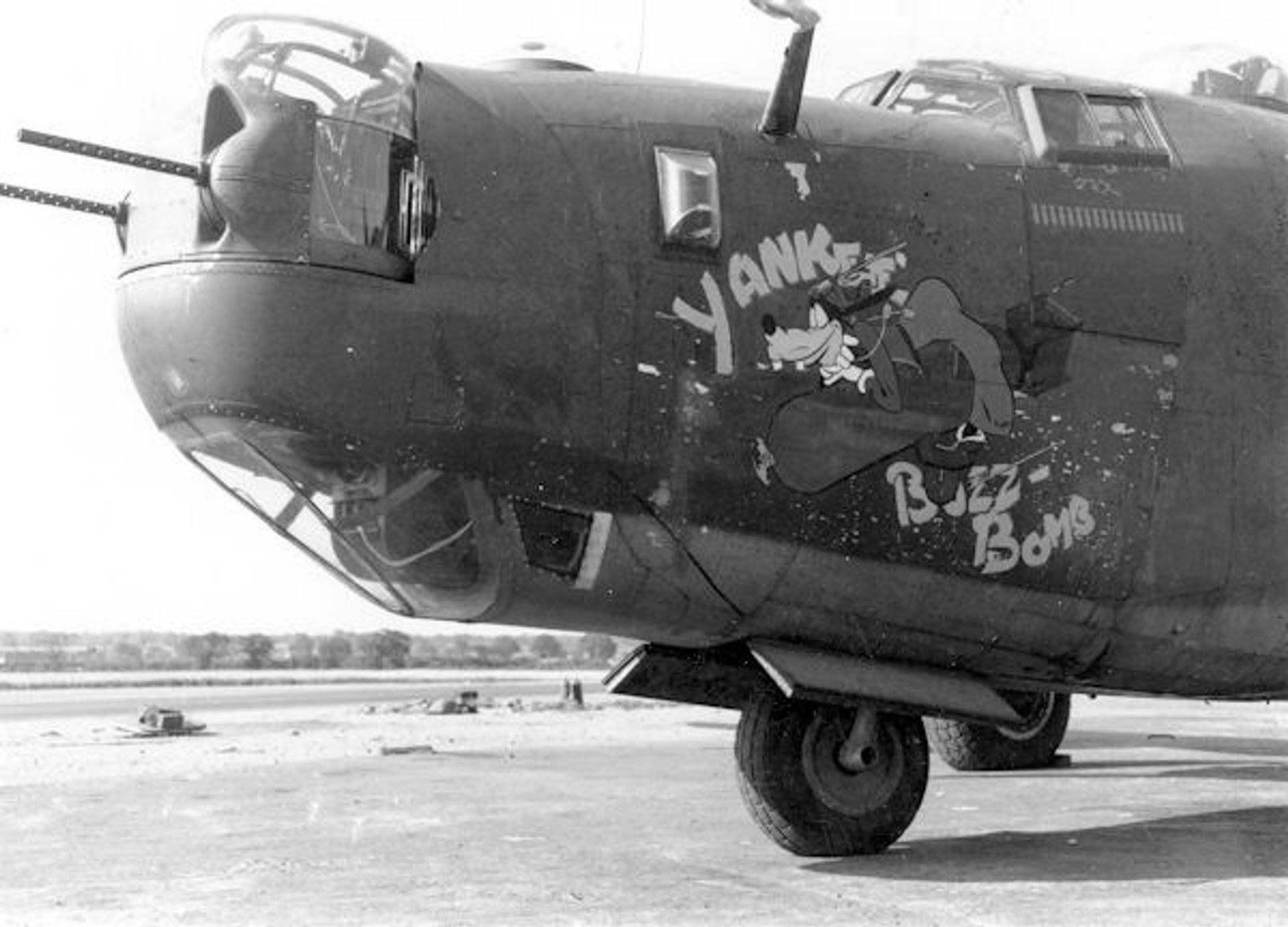
Mission No. ?
5 April 1945
Plauen
T.O. 0700 Land 1100
Ship 340N-7V [picured left, in May 1944 with O.D. paint]
Also see Stories – Ice and Fire
This mission, as it developed, did not turn out to be a mission for which we got credit, nevertheless it became such an eventful flight that I must recorded in these annals. We were briefed for a target in southeastern Germany near the Czech border. The M.P.I. was the marshaling yards at Hof. The weather, as briefed, was extremely bad. We went on instruments immediately upon take-off and flew thus for the entire four hours. The weather being so bad in the UK, we were obliged to make an assembly over the continent at Buncher 17, near Liege.
Upon arrival at Bu 17 at 16,000 feet we were still souped in. In an attempt to find the formation we left the buncher area. The airplane had been accumulating ice from the time we had taken off, however, the de-icers had taken care of it. Then it happened – we began stalling out, despite the fact that we were pulling 2300 (RPM) and 36″ Hg, and flying level. The only apparent danger seemed to be from excessive formation of ice on the wings and tail surfaces; ice that could not be broken by the de-icer boots.
In an effort to regain the lost airspeed and break the stall, I pushed the nose down. When we did get flying speed back I could not neutralize the elevator – it being apparently frozen in the down position, we rapidly lost altitude and gained air speed (it got up to 320 mph). Realizing that I had little control of the airplane, and no hope that control would return, I ordered the crew to prepare to bail out. When conditions worsened I gave the “bail-out” order. Everyone seemed to get out in good order. As I was preparing to leave my seat at about 7,500 feet, I noticed the nose rising slightly, I got back into the seat and began tugging on the controls which slowly returned to normalcy. The co-pilot had not bailed out as yet, so I motioned him back into the seat; he told the navigator who was in the bomb bay just preparing to jump. These were the only two crew members remaining. We regained complete control, but were still on instruments. Thereupon, I called “Nuthouse” (emergency radio station on the Continent). They instructed me to home in on a nearby field and land. Then I realized that the bombs were armed and the safety-pins went with the waist gunners, therefore we could not land with the bombs. After informing “Nuthouse” of this we proceeded to the Channel on the QDM. Before we arrived at the Channel the airspeed indicator went out; at this I instructed the navigator to keep reading the AS to us from his indicator. Then we lost contact with “Nuthouse”. We picked up “Colgate” (Air Sea Rescue) who gave us a QDM to jettison point and thence to base. Up to now we have news of only the nose gunner, engineer, and radio operator who landed close together in Belgium. They returned with a crew which landed in order to get repairs. The men in the waist are still unheard from. All in all a very eventful time, the sad part of it being we did not get credited for a mission. And so to bed.
Mission No. 7
7 April 1945
Lauenberg
T.O. 1000 Landing 1830
Ship 316H-7V
The target on this mission was a munitions dump southeast of Hamburg on the Elbe River. The takeoff was normal, although rather early in the morning. The weather over the Channel and most of the Continent was pretty cloudy, however the target area was visual. This mission was a maximum effort and we flew the fourth squadron in the No. 6 position. We carried 12 X 500 G. P. bombs. The target was really blasted. It being a munitions dump made the explosion an even greater one. Upon return to base the weather was socked in and an instrument landing was necessary. The route in and out was over the North Sea. Flak was present but inaccurate, fighters too were present, but did not attack our formation. The 458th still flies the best formation in the 2nd Division. Seven down, twenty-eight to go. And so to bed.
Mission No. 8
10 April 1945
Neustrelitz
T.O. 1050 Landing 1830
Ship 340N-7V
Today’s mission was a good hop. We experienced very little difficulty, save for a vapor lock in the fuel transfer system which was remedied before any damage was done. The target was another airfield in the Berlin area near Lake Moretz. We came in from the North Sea and saw no flak (thank God) in the target area. However fighters were present, but our escort kept them from attacking the formation. We flew in the second squadron in the No. 7 position, lead of the high right. This was the first time I have led this element and I had a rather rough time of it. We carried 10 X 500 lb G. P. bombs which all hit smack in the MPI which was the intersection of the runways. Someone said they saw a Jerry fighter attempting to take off from this field at “bombs away”, and was blown up when the bombs struck. Tough! One squadron of the wing failed to drop on the first run due to cloud cover, so we did a 360 and went over the target again. Again, I say thank God for no flak! The trip back was uneventful, it being visual all the way home. For the first time we didn’t have to sweat out the gas – we landed with over 1000 gallons. Good mission! Eight down, twenty-seven to go. And so to bed.
Mission No. 9
11April 1945
Regensburg
T.O. 0900 Landing 1730
Ship 350N-7V
Today’s mission was a long one but not too bad as very little of it was high altitude. Our target was an oil refinery and storage depot at Regensburg in southeast Germany, about 50 miles southeast of Nuremberg on the River Danube. Our bomb load consisted of 52 X 140lb M17 incendiaries and 2700 gallons of gas. Due to weather we were unable to take advantage of an assembly over England and were obliged to assemble over Liege, Belgium. This was accomplished in good order and we set out on course at 6,000 feet, we did not begin to climb until shortly before we crossed the enemy lines, and did not reach bombing altitude (22,000 feet) until 20 minutes before the IP. It was a long bomb run, and we expected to get the briefed flak from 36 guns at the target, and we got it too. We were in the third squadron in the number 6 position, and the entire side of the formation received a number of hits. Again we were lucky and suffered only slight damage to the wings and tail surface. On the return we flew the same course and let-down immediately after bombs away, and flew all the way across Germany, France, and Belgium at 10,000 feet. This afforded an excellent opportunity to see the damage that war has wreaked on these nations. Saw bombed towns, bridges, airfields, etc. Nine down, twenty-six to go. And so to bed.
Mission No. 10
15 April 1945
Gironde Estuary
T.O. 0610 Landing 1450
Ship 340N-7V [pictured at right on this mission]
Also see Stories – Ice and Fire
This was my first mission which was tactical rather than strategic in nature. The target was one of the many remaining pockets of Wehrmacht resistance on the French coast – this being the farthest south, about 50 miles north of Bordeaux. It is estimated that over 200,000 German soldiers are remaining in this sector, having heavily fortified themselves against the possibility of attack. We made a pre-dawn take off and assembled over the Continent at Liege, Belgium. From there we flew south through France to the target and back over the Bay of Biscay, Brittany, and southern England – hitting the English coast at Southampton.
This also marked the first time we carried a new type of incendiary (Napalm) a highly inflammable gelatinous form of gasoline. This jelly was placed in the conventional fighter belly tanks each weighing about 500 pounds. We carried eight such bombs. Since this target had been hit yesterday by the entire 8th AF, and again today by the 8th there cannot be much remaining. French troops were scheduled to attack an hour after we left the target. The MPI assigned to the 458th was a barracks and building area. It couldn’t be determined whether we hit it or not as a complete blanket of smoke from preceding wings palled the target area. We flew in the No. 3 position of the third squadron, and bombed at 15,000 feet. This was a good opportunity to get a good look at western and southern France, something I hadn’t been afforded before. The country is really quite beautiful – small farms, villages, vineyards, all picturesque in reminiscent of Rousseau, Van Gogh, Zola, etc. Ten down, twenty-five to go. And so to bed.
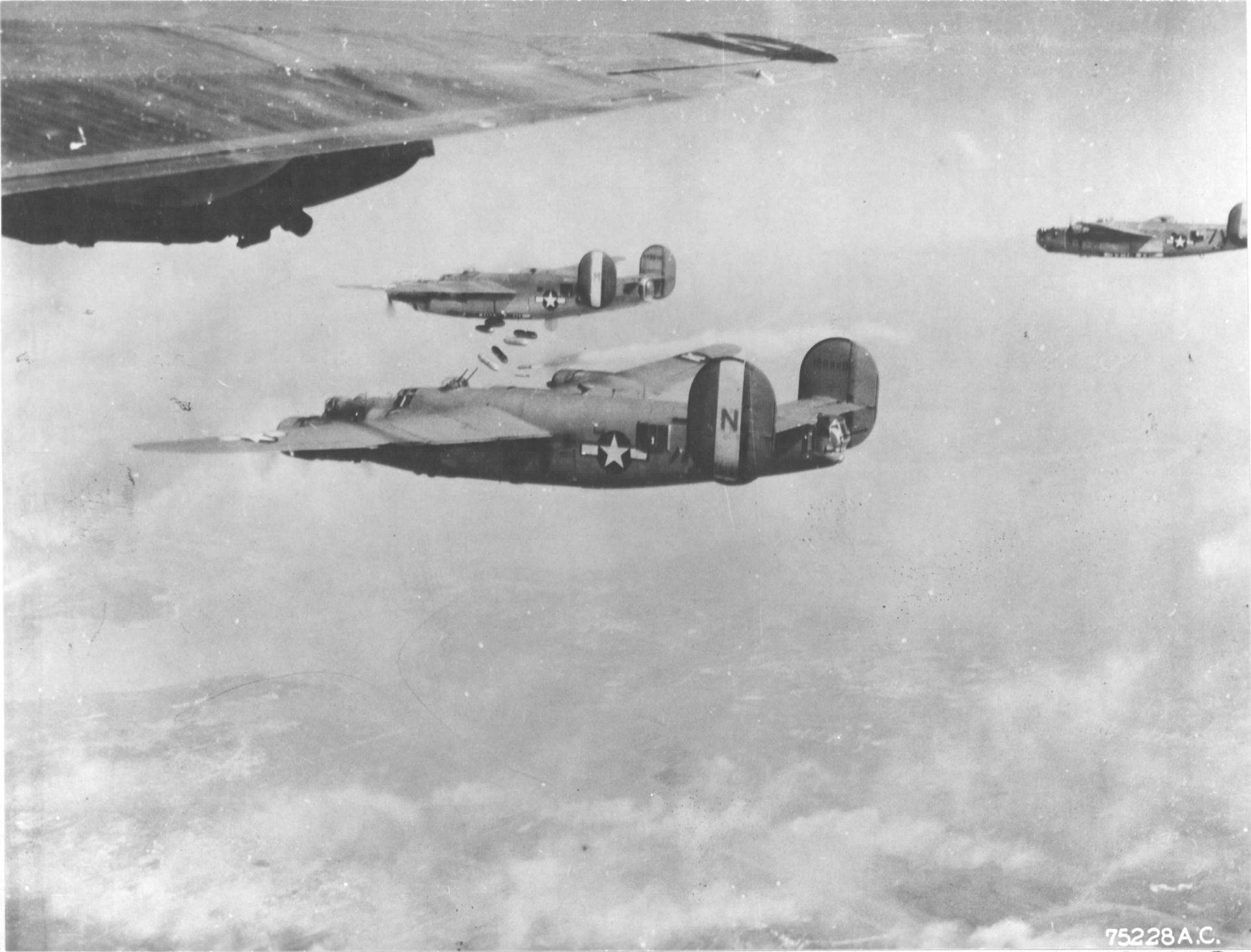
Mission No. 11
18 April 1945
Passau
T.O. 0945 Land 1750
Ship 352K-7V
A long, but trouble-free mission today. For the first time in many days I completed a mission without any visible difficulty. This may be due in part to the fact that we saw no flak or fighters throughout the mission. And it didn’t seem too long as a good part of it was at low altitude. We carried 5 X 1000 G. P. bombs for the primary target at Munich. However this target was covered by clouds, consequently we hit the secondary – marshaling yards at a town on the German-Austrian border, (this is about the furthest east I have ever penetrated). We flew in the lead squadron of the lead group in the number 5 position. Unfortunately, bombardiers in the first two squadrons made gross sighting errors and all bombs of these two squadrons fell over the target about 5,000 feet. In fact our bombs struck dangerously close to a hospital, but apparently none struck any of the hospital buildings. The route was a more or less straight southeasterly one after making landfall at Walcheren Island, northwest of Antwerp, we withdrew the same way. On the whole this was a good mission from virtually every standpoint. Eleven down, twenty-four to go. And so to bed.
Mission No. 12
20 April 1945
Zwiesel
T.O. 0740 Land 1545
Ship 110M-7V
Another of those long hauls down into southeastern Germany near the Czech border. Our Target today was a railway bridge across the Danube and marshaling yards in the town of Zwiesel. We carried 5 X 1000 lb G.P. bombs and 2700 gallons of fuel. We took the usual cruise – hitting the Continent at Walcheren Island and thence southeast past Antwerp, Cologne, Aachen, Frankfurt and Nurnberg. Most of it was low altitude and thus we got an opportunity to get a better look at what remains of Germany. We hit the target at 1200 and left a pall of smoke seen for 100 miles. Again we were fortunate and encountered no flak or enemy fighters. We had a little trouble with number 3 prop governor – couldn’t change pitch unless we used the feathering switch. We were in the second squadron in the number 6 position. The second and third squadrons hit the targets successfully; however, the first went right over the target without dropping and bombed a railway junction nine miles north of the original target. The weather was visual and good throughout the mission. Twelve down, twenty-three to go. And so to bed.
June 1945
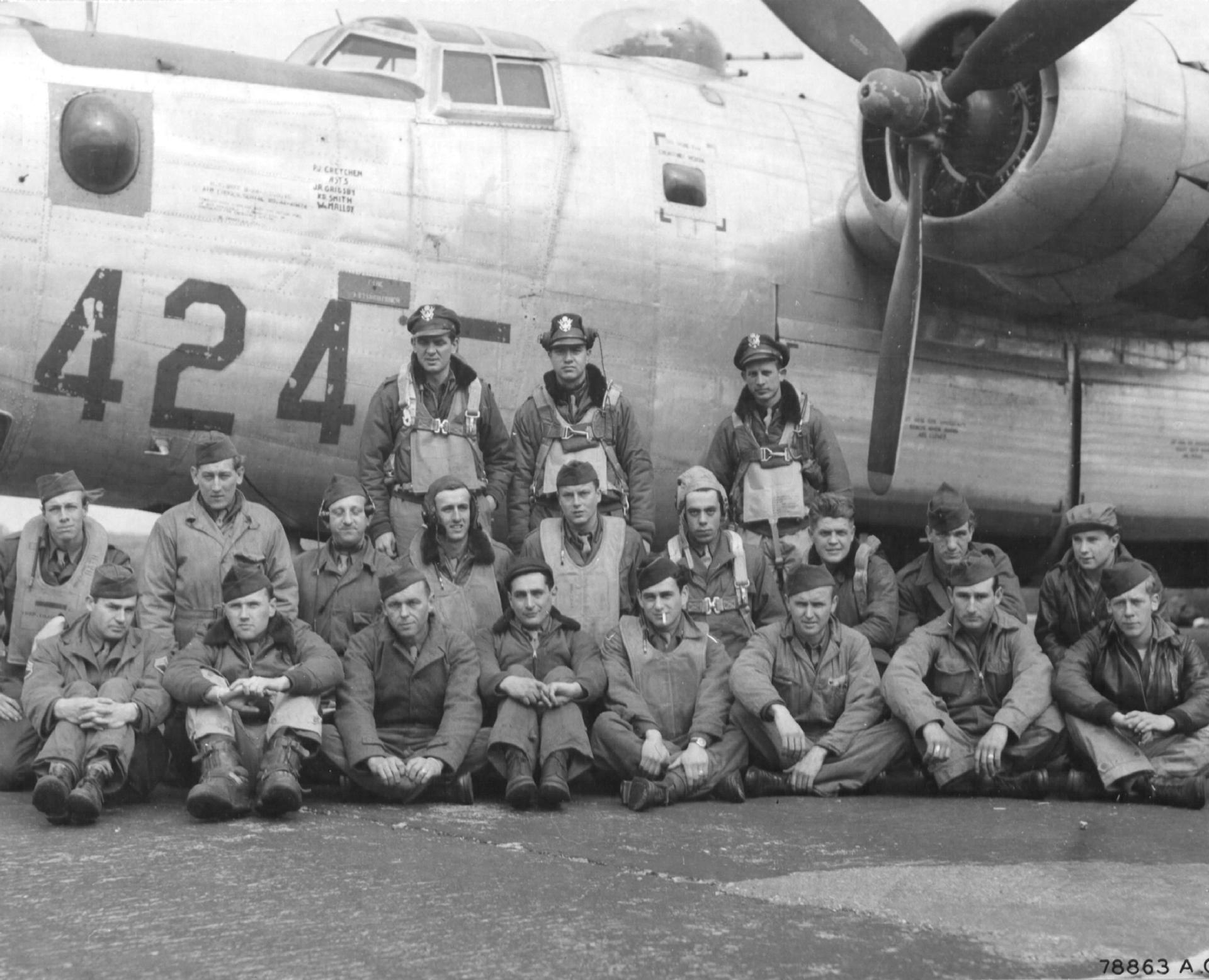
Standing: Paul Gable, Ed Holmgren, Herman Bull
Kneeling: Paul H. Myers, Unknown, Unknown, Wayne Austin, Unknown, Harry Schafer, Ted Semchuck, Joe Metosh, Tom Richardson
Sitting: Dean Burke (2nd, left); Rollin Helbling (far right)
If you can identify anyone, please contact me.
7 June 1945
Under authority contained in Letter ETOUSA, Subject: “Movement Orders, Shipment 10060”, File No. AG 370.5, OPGC, Dated 27 May 1945, the following A/C and personnel assigned thereto will proceed via Valley A/D by best available air route to Bradley Field, Windsor Locks, Connecticut, thence to Camp Miles Standish, Boston, POE. Personnel will report to the AAF Base Commander at Bradley Field. AAF personnel are being returned for the purpose of authorized TD for rest and recuperation and for further assignment. Personnel listed on this order are on Detached Service and are being accounted for on Morning Report of the Air Echelon of the Squadron to which they are asgd. TDN 212/50425 FSA 1942-45 60-136 P-431-02.
Shipment No. 10060-TZ T-M-S: B-24J A/C Serial No. 44-40424 Crew No. 3 of 18
| Name | Grade | Arm/Svc | ASN | Crew Spec/Job | MOS | Home |
|---|---|---|---|---|---|---|
| Holmgren, Edward L | 2Lt | AC | 02057216 | Pilot | 1092 | Chicago, IL |
| Bull, Herman W | F/O | AC | T-64227 | Co-pilot | 1092 | Chicago, IL |
| Gable, Paul H | 2Lt | AC | 02073104 | Navigator | 1034 | Box Elder, MT |
| Austin, Wayne L | Sgt | AC | 34984302 | Gunner | 611 | Newbern, TN |
| Metosh, Joseph R | S/Sgt | AC | 33631930 | Flight Engineer | 748 | Petersburg, VA |
| Helbling, Rollin A | S/Sgt | AC | 36824907 | Radio Operator | 757 | Milwaukee, WI |
| Burke, Dean W | Sgt | AC | 32938156 | Gunner | 611 | Syracuse, NY |
| Richardson, Thomas L | Sgt | AC | 18242507 | Gunner | 611 | Dallas, TX |
| Schafer, Harry F | Sgt | AC | 42093502 | Gunner | 611 | Lockport, NY |
| Semchuck, Ted (NMI) | Sgt | AC | 35606587 | Armorer-Gunner | 612 | Akron, OH |
| Wilkerson, Campbell (NMI) | S/Sgt | AC | 38211210 | Crew Chief | 750 | Walnut Ridge, AR |
| Allison, Charles W | Sgt | AC | 18057697 | Crew Chief | 750 | Channing, TX |
| Brown, Manford L | Cpl | AC | 37505178 | Radio Mechanic, AAF | 754 | Graham, MO |
| Marks, Richard D | Sgt | AC | 12153703 | Radar Mechanic, Bombardment | 867 | Brooklyn, NY |
| Lemons, Jesse E | S/Sgt | AC | ?8074895 | Radar Mechanic, RCM | 852 | Snyder, TX |
| Cooperstock, Henry (NMI) | S/Sgt | AC | 32399193 | Administrative NCO | 502 | New York, NY |
| Myers, Paul H | Pfc | AC | 13004171 | Radio Operator, AAF | 756 | Alhambra, CA |
| Lubet, Fred (NMI) | Cpl | AC | 33678595 | Radar Mechanic, IFF (LORAN) | 862 | Pittsburgh, PA |
| Dudgeon, Laurance T | Sgt | AC | 39118149 | Airplane & Engine Mechanic | 747 | Oakland, CA |
| Elias, Sidney H | Sgt | AC | 32499796 | Airplane & Engine Mechanic | 747 | Park Ridge, NJ |
